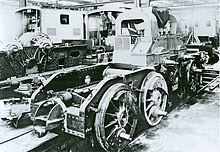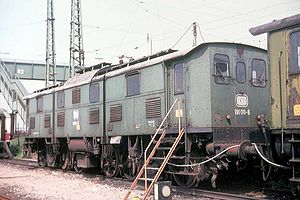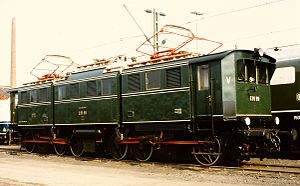DR series E 91
The E 91 series included three different types of electric freight locomotives from the Deutsche Reichsbahn-Gesellschaft . In addition to the two standard locomotive types described below, there was a former Prussian type EG 538abc to EG 549abc , which from 1927 bore the class designation E 91.3.
E 91.0 and E 91.8
| DR class E 91 DB class 191 |
|
|---|---|
|
Bavarian E 91.0, decommissioned, from 1983 stationary device
|
|
| Numbering: | DRG E 91 01-20, 81-94 DB 191 001-020, 081, 088-094 |
| Number: | 34 |
| Manufacturer: | Krauss , WASSEG |
| Year of construction (s): | 1925-1927 |
| Retirement: | 1975 |
| Axis formula : | C'C ' |
| Gauge : | 1435 mm ( standard gauge ) |
| Length over buffers: | 16,700 mm |
| Total wheelbase: | 11,760 mm |
| Service mass: | 123.7 t |
| Wheel set mass : | 20.7 t |
| Top speed: | 55 km / h |
| Hourly output : | 2,200 kW |
| Continuous output : | 1,660 kW |
| Starting tractive effort: | 294 kN |
| Performance indicator: | 17.8 kW / t |
| Driving wheel diameter: | 1,250 mm |
| Power system : | 15 kV 16 2/3 Hz AC |
| Power transmission: | Overhead line |
| Number of traction motors: | 2 double motors |
| Drive: | Helical rod drive, Winterthur type |
| Train brake: | Compressed air brake type Knorr |
history
As early as 1922, the Deutsche Reichsbahn ordered 30 heavy goods train electric locomotives with the C'C 'wheel arrangement for mountain service as part of its first procurement plan for electric standard locomotives . The delivery was carried out by Krauss (mechanical part) and WASSEG (electrical equipment) in 1925 and 1926. 16 locomotives were allocated to the Bavarian network. They received the designation EG 5 22 501-516 from the Bavarian group administration . The other 14 machines were used as EG 581 Breslau to EG 594 Breslau in the Silesian network . From 1927 they were given the company numbers E 91 01–16 (Bavarian variant) and E 91 81–94 (Prussian variant). In 1927 another four locomotives were delivered, which had been ordered with Bavarian company numbers, but were delivered with the new numbers E 91 17-20 .
The E 91 and E 77 series were designed very similarly. The three-axle motor chassis of the E 91 had an inner frame. A double motor drove the axles of a drive frame via a Winterthur helical rod drive. The structure was in three parts. The end parts had an end operator's cab and an engine room and were firmly seated on the drive frames. The middle part was rotatably placed on ball pins of the drive frames. The transitions between the individual sections of the engine room were secured by bellows, there were no partition walls. The Bavarian locomotives could be distinguished from the Silesian locomotives by the additional front door between the two driver's cab windows (see illustration on the right of the Bavarian E 91 11, parked in the Frankfurt AW as a stationary transformer for the test field; compared to the E 91.9, this has side ventilation slots at the bottom) . The machines should be able to move goods trains weighing 1200 t at 35 km / h and passenger trains weighing 500 t at 45 km / h on a 10 ‰ gradient. Since the locomotives were a little heavier in production, test drives with 1,400 t load were carried out with them, which the locomotive, still designated as EG 582 , was able to perform on a 10 ‰ ramp on the Silesian Mountain Railway between Lauban and Langenöls . The required service program could thus be exceeded by 16%. Since the locomotives were intended for freight trains and steep routes that did not require high speeds, the machines met the expectations placed on them. Due to the high friction weight , they were particularly suitable for this service. She was not aware of any running problems like the E 77 , but the top speed was 10 km / h lower. The design of the locomotive was used to build the E 60 , which is practically a halved version of the E 91 .
With the DR, the southern German machines always stayed in Bavaria ( Bw München Hbf , Regensburg , Rosenheim and Freilassing ). The Silesian machines with which the delivery began in 1925 were located at the Hirschberg depot. Of them 1933 were E 91 89 and 90 for Bw Kornwestheim to E and 91 91 and 92 Bw Ulm of Rbd Stuttgart implemented. In 1943 E 91 81, 88 and 93 came to Bavaria, in 1944 E 91 82 followed and in 1945 E 91 94 came to the Augsburg depot .
The remaining E 91 83 to E 91 87 were transferred to the Soviet occupation zone in autumn 1945 . They came to the USSR in 1946 as reparations . After their return in 1952/53, they remained on hold. A restart for the Rübelandbahn was not seriously pursued, as it was relatively soon clear that this route would be electrified with 25 kV, 50 Hz. The locomotives were retired in 1962 and scrapped in 1965.
Of the southern German locomotives, the E 91 05 and 1944 the E 91 17 were retired in 1934. After further decommissioning, the 17 locomotives E 91 01-03, 07-11, 13, 15, 16, 18, 20, 81, 88, 89 and 94 remained in the DB's inventory from 1950 and were modernized between 1958 and 1960, with before especially the electrical equipment was renewed. The driver's cabs were changed (removal of the transition equipment and window screens, third front window added). With the introduction of the computer-compatible company numbers, the locomotives carried the series designation 191 and three-digit serial numbers from 1969 . In the last few years the machines were not only at home in southern German depots, but also with the Oberhausen depot in the Ruhr area . Because of their low top speed, they were mainly used in shunting services. Here, their frictional weight for service on ramps ensured the long survival of the locomotives, which were up to 50 years old. They were retired between 1969 and 1975.
technical description

Each of the two three-axle motor bogies was a rivet construction with sheet metal frame cheeks with a thickness of 25 mm. They were stiffened by the cast steel motor pan, the buffer beam and the end girders that carried the sliding sockets for the storage of the middle locomotive body. The sliding pans of the end girders also caused an even load on the axles of the motor bogies. The tractive effort was transferred to the other motor bogie via the middle locomotive body. In contrast to the middle piece, the end pieces of the locomotive body were firmly attached to the motor bogies. These locomotive bodies carried the driver's cabs and, separated from them by partitions, the engine rooms with the electric traction motors. The main transformer , its fan and oil cooler as well as the air compressor were housed in the middle section .
The outer wheel sets of the motorized bogie were firmly mounted, the middle ones had a side play of 25 mm. The axles were driven by a jackshaft via a Winterthur helical rod drive . The jackshaft was driven by a spring-loaded, straight-toothed motor pinion from two double motors on the large wheel of the jackshaft.
The main transformer was oil-cooled and constructed as a jacket transformer. It had an output of 2,050 kVA. A contactor control was used to tap ten different winding segments for setting the power of the traction motors. The ten-pole drive motors and their control with 19 speed levels were largely similar to that of the bay. EP 5 identical. The two motors on each bogie were permanently connected in series and each double motor had its own fan . The change of direction of travel was carried out via four gates arranged behind each double motor.
Web links
E 91.9
| DR class E 91 9 DB class 191 |
|
|---|---|
|
E 91 99, issued at "150 Years of the German Railway" in Bochum 1985
|
|
| Numbering: | DR E 91 95-106 DB 191 097-102 |
| Number: | 12 |
| Manufacturer: | AEG , WASSEG |
| Year of construction (s): | 1929 |
| Retirement: | 1975 |
| Axis formula : | C'C ' |
| Gauge : | 1435 mm ( standard gauge ) |
| Length over buffers: | 17,300 mm |
| Total wheelbase: | 12,450 mm |
| Service mass: | 116.4 t |
| Wheel set mass : | 19.6 t |
| Top speed: | 55 km / h |
| Hourly output : | 2,200 kW |
| Continuous output : | 1660 kW |
| Starting tractive effort: | 294 kN |
| Performance indicator: | 18.9 kW / t |
| Driving wheel diameter: | 1,250 mm |
| Power system : | 15 kV 16 2/3 Hz AC |
| Power transmission: | Overhead line |
| Number of traction motors: | 2 double motors |
| Drive: | Helical rod drive, Winterthur type |
| Train brake: | Compressed air brake type Knorr |
history

As more electric locomotives became necessary due to network expansion and increasing traffic, the Deutsche Reichsbahn-Gesellschaft ordered twelve E 91 series locomotives in 1927 to cover the most urgent needs. The locomotives should have an electric brake for moving heavy trains on long downhill stretches. In addition, the original design had to be changed to save weight. As a prototype for testing the electric brake, the E 95 02 was equipped with it upon delivery.
The machines were delivered in 1929 by AEG and WASSEG (consortium of AEG and SSW) as E 91 95-106 and stationed for operation in the Silesian network at the Waldenburg-Dittersbach depot. They differed from the original version of the E 91 series not only technically in terms of their lower weight (weight savings, especially with the traction motors) and the electric brakes, the locomotives had become longer. There was no difference in performance between the two types. Outwardly, the newer machines were easy to recognize by the three large cab windows and the side ventilation grilles, all of which were located at the level of the engine room windows. To distinguish them from the older version, they were given the series designation E 91 9 .
The E 91 96 was retired after an accident in 1943 and dismantled in southern Germany after the end of the war . Before the end of the war, the E 91 95 to E 91 102 were brought to southern Germany. At the end of the war, E 91 104 was bombed in the RAW Dessau. The E 91 103, 105 and 106 were also brought there in October 1945. These three machines and spare parts from the dismantled E 91 104 reached the Soviet Union in 1946 as part of the reparations deliveries . After their return in 1952/53, they remained parked and were retired in 1962 and scrapped the following year.
In the case of E 91 95, the war damage was no longer repaired. It was retired in 1949. The other locomotives (E 91 97-102) were in operation with the Deutsche Bundesbahn and were modernized between 1957 and 1960 according to the E 91.0. With the introduction of the EDP series scheme on January 1, 1968, they were redrawn as 191 097-102 . They were withdrawn from service in 1974 (191 097, 098, 102) and 1975 (191 099-101).
On November 27, 1975, the 191 099, the last locomotive of the 191 series, was retired. It was preserved as a museum locomotive. On the occasion of the 150th anniversary of the railroad in Germany (1985), the locomotive was made operational with parts of the 191 100 and was able to take part in the anniversary parade while driving. After various damage, it had to be turned off again. It is located in the Bahnpark Augsburg .
Technical details
The differences to the original variant concerned the wheelbase in the motor bogie, which was increased by 200 mm, and the axle base of the locomotive, which was increased by 300 mm by moving the motor bogies apart. The reason for this was the need to gain space to accommodate the drag brake . In contrast, it was possible to save 50 mm between the outer axis and the buffer beam.
Furthermore, the electrical system had been revised for the purpose of additional load from the resistance brake. The completely redesigned transformer was 2,900 kg lighter, and the motor housing was reduced by 2,300 kg. Further savings meant that the total weight of the locomotives was 7,300 kg lighter than the original variant. The roof equipment has been revised. Since faults occurred in the original version due to the formation of ice on the pantograph contacts , the modified locomotives were given a disconnector that could be operated from the engine room .
Web links
- The E 91.9 in use on the Silesian Mountain Railways
- Company photo of the E 91.99 on www.bahnbilder.de
- E91 94 1964 on the Joachim Schmidt Railway Foundation
- E91 10 1960 on the Joachim Schmidt Railway Foundation
literature
- Horst J. Obermayer: Paperback German electric locomotives . 7th edition, Franckh'sche Verlagshandlung, Stuttgart 1986; ISBN 3-440-03754-1 .
- Dieter Bäzold, Günther Fiebig: Railway Vehicle Archive 4, Electric Locomotives of German Railways . Alba-Verlag, Düsseldorf / Transpress Verlag, Berlin 1984; ISBN 3-87094-106-5 .
- Glanert / Borbe / Richter Reichsbahn electric locomotives in Silesia VGB-Verlag 2015, ISBN 978-3-8375-1509-1 .
- Bernd Beck The Wechmann-Plan-Electric standard electric locomotives for the DRG in Eisenbahnkurier 10/2016, EK-Verlag Freiburg
Individual evidence
- ↑ Glanert / Borbe / Richter Reichsbahn-Elloks in Schlesien VGB-Verlag 2015, ISBN 978-3-8375-1509-1 , page 68
- ↑ Glanert / Borbe / Richter Reichsbahn-Elloks in Schlesien VGB-Verlag 2015, ISBN 978-3-8375-1509-1 , page 62
- ↑ Glanert / Borbe / Richter Reichsbahn-Elloks in Schlesien VGB-Verlag 2015, ISBN 978-3-8375-1509-1 , page 65
- ↑ Glanert / Borbe / Richter Reichsbahn-Elloks in Schlesien VGB-Verlag 2015, ISBN 978-3-8375-1509-1 , page 66


